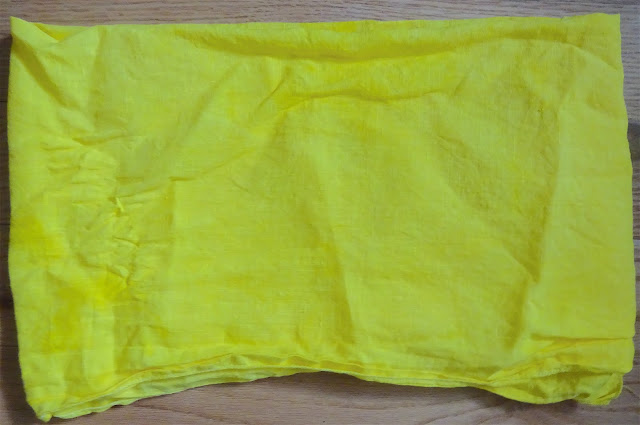 |
| Dyed with turmeric; it is a spectacular yellow. |
Ethnobotanists suggest that the intense yellow color from the powdered rhizome was critically important to the rise of turmeric as a ceremonial and magical plant. Turmeric was linked to sun gods and through them to the daily and yearly cycle. Turmeric was also sacred to earth goddesses, perhaps because some tropical soils are intensely yellow. Furthermore, its color is that of ripe fields of rice. Since much of India and Southeast Asia depends on rice, it was used in agricultural ceremonies and rituals for successful harvests and the ensuing prosperity.
 |
| turmeric |
All across Hindu India and wherever Hindu influence has reached, rice colored yellow with turmeric is a symbol of prosperity and essential in ceremonial situations from religious offerings to feasts and festivals.
Other cultures also took up turmeric for its color. It is thought to be one the yellow spices used in Persian sun worship. In Polynesia, Micronesia, and Hawaii, turmeric in sea water consecrated and purified sacred places and objects.
The powdered rhizome makes an intense yellow dye, important for dyeing cloth from India to Hawaii. Young tubers make an intensely bright yellow, older tubers a deeper golden yellow. It is the only known natural material that will dye cotton without a mordant, and likewise strongly dyes other bast fibers such as linen and Hawaiian tapa cloth. (Mordants are metal ions, of aluminum and iron for example, that link the colored molecule to the fabric; without them most plant dyes immediately wash away.)
 |
| cotton dyed with turmeric, neutral or acid pH yellow plastic stick for color reference |
However, with about two teaspoons of baking soda, the dyebath turned reddish and white cotton dyed a rusty shade. (You can see a reddish tinge; the thread shows it best).
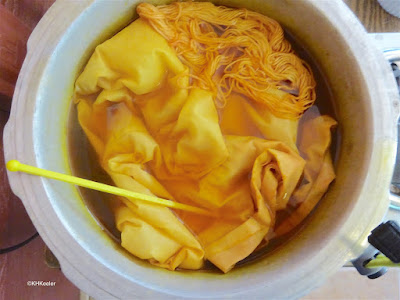 |
| cotton dyed with turmeric, alkaline pH yellow plastic stick for color reference |
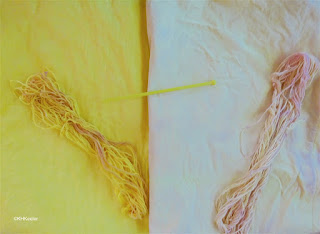 |
| Cotton dyed with turmeric, no mordant left, slightly acid dyebath, right alkaline dye bath |
Here I tested the reported pH sensitivity for myself. This old pillowcase is the one I dyed with turmeric in an alkaline solution. I dropped a drop of vinegar on it. You can see the big yellow circle (lightly outlined). Wherever it spread, the vinegar changed the mottled reddish background to bright yellow (actual size of dot about 2"). You can also do the reverse: alkaline drops create red from turmeric-dyed cloth that is yellow (see below).
You can read that turmeric produced the saffron-colored robes of Buddhist monks, and given the importance of turmeric in India in Buddha's time and since, that seems reasonable. However, across the Buddhist world, robe colors vary greatly, so, at best, some of the robes were and are dyed with turmeric, usually blended with other dyes and substances.
The color transformation--turmeric forming a strong yellow in an acid or neutral solution and turning reddish brown if the solution is alkaline--has been known a very long time. Chemists took advantage of it to create indicators, which will easily tell you whether a solution is acid or alkaline (basic). You can do it with solutions (demo online link). Liquids not being particularly convenient, chemists invented turmeric paper, which is made by drying a turmeric solution on paper. The paper, or the solution, is yellow when it is acid, reddish when alkaline and has the very cool property can be used to determine the neutral point (pH 7), because that is when the red turns yellow (or vice versa).
Here I used the cloth I had dyed as if it were turmeric paper. I made soapy water (alkaline) and put a drop on the previously-dyed cloth. It turned the spot a deep reddish shade. Acids like vinegar made no change.
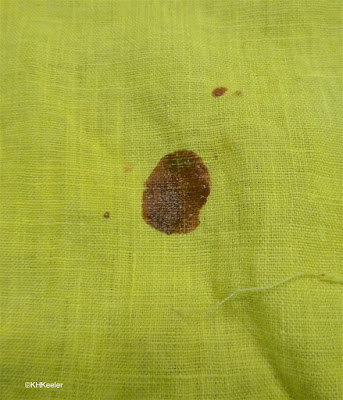 |
| My own indicator. Clear soapy water made the red drop as the turmeric changed color. |
As mentioned in the previous post, turmeric has a variety of medicinal uses and very low toxicity. Adding it to your foods will turn them yellow (or red). Or try it on your skin, it cleanses and disinfects (see lots of online suggestions). Dye cloth with it, just don't expect the color to last. Don't leave it just sitting in your spice cabinet.
 |
| turmeric leaves, Curcuma longa |
Comments and corrections welcome.
Sources
Alexander, R. 2018. What Is the Meaning of Turmeric in Hinduism? Classroom.com link
Cardon, D. 2007. Natural Dyes. Archtype Publications, Ltd., London.
Crohn-Ching, V. F. 1980. Hawaii Dye Plants and Dye Recipes. University of Hawaii Press, Honolulu.
Patnaik, N. 1993. The Garden of Life. An Introduction to the Healing Plants of India. Doubleday, New York.
Prabhakaran Nair, K. P. 2013. The Botany of Turmeric. The Agronomy and Economy of Turmeric and Ginger. online at Science Direct link (Accessed 5/27/20)
Prasad, S. and B. B. Agrawal. 2011. Turmeric, the Golden Spice. Herbal Medicine: Biomolecular and Clinical Aspects. 2nd edition. NCBI, NIH (National Institutes of Health) link (Accessed 5/27/20)
Sopher, D. E. 1964. Indigenous uses of turmeric (Curcuma domestica) in Asia and Oceania. Anthropos. 59 (1/2): 93-127.
Kathy Keeler, A Wandering Botanist
More at awanderingbotanist.com
Join me on Facebook: https://www.facebook.com/AWanderingBotanist
Check out my books (on Amazon) with collected stories of familiar plants:


Check out my books (on Amazon) with collected stories of familiar plants:


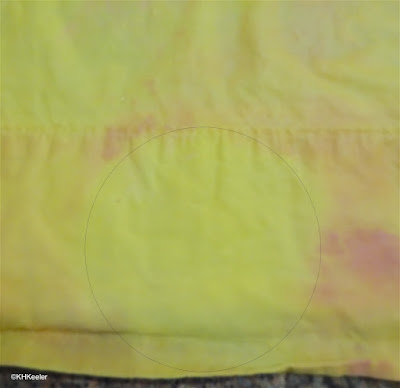
No comments:
Post a Comment